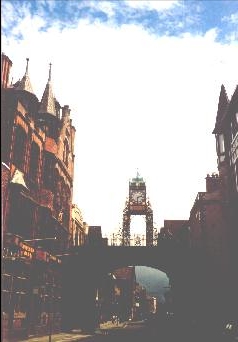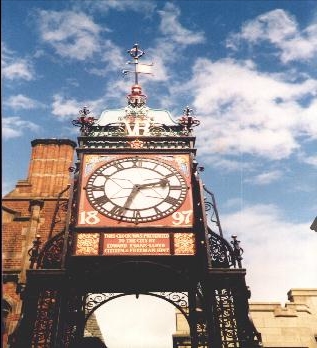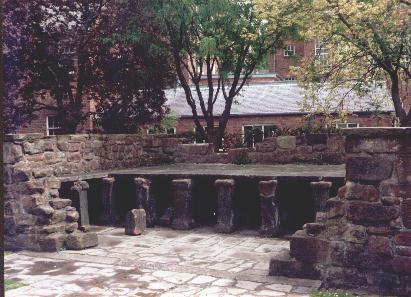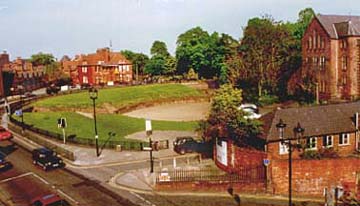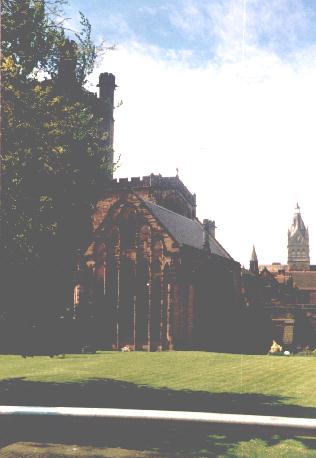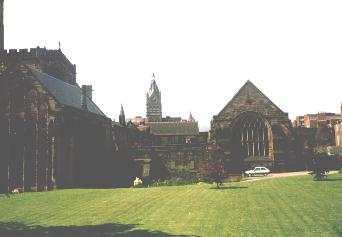 Greenteeth Labyrinth Greenteeth Labyrinth
Travel Section
The Land Of Dragons and Druids: Part 3
by
Ian Thorpe
Many travellers to planning a trip to Britain focus on London, Edinburgh, maybe a trip to Stonehenge, a guided tour of Shakespeare's Stratford and perhaps a visit to the Roman cities of Eboracum (York) or Deva (Chester.) The true delights of Britain are well of the tourist trail though, we keep them for ourselves. The adventurous traveller should remember that Britain is made up of three countries each with its own history and distinct culture. The smallest of these nations is as rewarding to visit as either of the others and has more that is worth exploring crammed into its two thousand square miles than you might find in a million square miles of the central Asian steppes. One lifetime is just not enough to do justice to Wales.
Creative Commons: Some rights reserved (non commercial, attrib, no derivs.
All reproductions in whole or in part should link to Greenteeth Multi Media Productions http://www.greenteeth.com/index |
The Land of Dragons and DruidsPage 3
The main road from Cei Newydd is a comfortable drive but let's wend our way along the coastal route, through a maze of narrow, winding lanes. We have plenty of time.Cwm Tudu or the Bay of Seals can be accessed by road but only if you have a small car. Take your own refreshments, when we visited there were no shops. And in the unlikely event of meeting someone coming the other way be prepared to reverse a few hundred yards. But when you get there it is a place of great tranquillity and beauty.
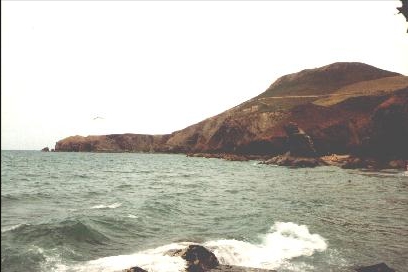 Cwm Tudu means Bay of Seals. If you look very closely on the picture towards the right and about a third up from the bottom the small black dot is a seals head. They seemed reluctant to pose for the camera, but on that day a group of young men on the beach were having great fun throwing stones when the creatures came close to the beach. Our politicians, when justifying tax increases like to tell us what a wonderful education system they provide.
Cwm Tudu means Bay of Seals. If you look very closely on the picture towards the right and about a third up from the bottom the small black dot is a seals head. They seemed reluctant to pose for the camera, but on that day a group of young men on the beach were having great fun throwing stones when the creatures came close to the beach. Our politicians, when justifying tax increases like to tell us what a wonderful education system they provide.
If it is so wonderful you might think educationalists could find a way to teach a sense of responsibility.
NB the white sky is not a local weather feature, the photos were taken on a dull day and the colour was washed out of the sky in order to bring up the detail of the landscape.

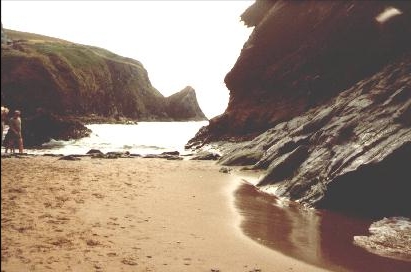
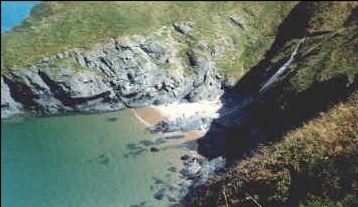
Above left: Among the rocks. Above right: One of the many small inlets along this stretch of coast. It is possible to scramble down a rocky path to this one but as we noticed some nature lovers were taking advantage of the seclusion to get their kit off and sunbathe we decided not to disturb them.

The next place we encounter is Llangranog, a picture postcard village with a beautiful beach. There is little to say about it, but it is worth two pictures.

Back on the scheduled tour route we come to the main town of the area, Cardigan. This Castle has been threatened with destruction recently, not from the cannonballs and siege engines it was built to withstand, but from a more pernicious threat of the modern age, the needs of car drivers. Fortunately a road bypassing the town centre with its narrow streets takes through traffic away from the ancient stones and a huge restoration project is under way.
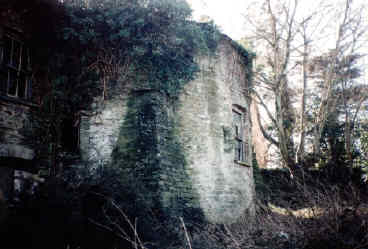 Because of the urbanisation surrounding the Castle there is not really a good viewpoint but on the day we visited we did manage some good interiors, showing the subterranean passages that were a feature of so many medieval castles. These often provided an escape route for the Lord and his family if things were getting too hot.
Because of the urbanisation surrounding the Castle there is not really a good viewpoint but on the day we visited we did manage some good interiors, showing the subterranean passages that were a feature of so many medieval castles. These often provided an escape route for the Lord and his family if things were getting too hot.

This is as far south as we go on a tour of Mogwydds Land although there is plenty to see further south such as the ancient city of St. David's, officially the smallest place in Britain that has the Royal Charter officially constituting it as a city, the spectacular Pembroke Castle and the Pembrokeshire coastline with its unique ecology, the major resort of Tenby; Cardiff the Welsh Capital.
We are going to turn inland here and head towards the market town of Newcastle Emlyn to a place that has a link between the time of the Celts and the present. Cenarth Falls on the River Afon Ceri is more rapids than a waterfall.
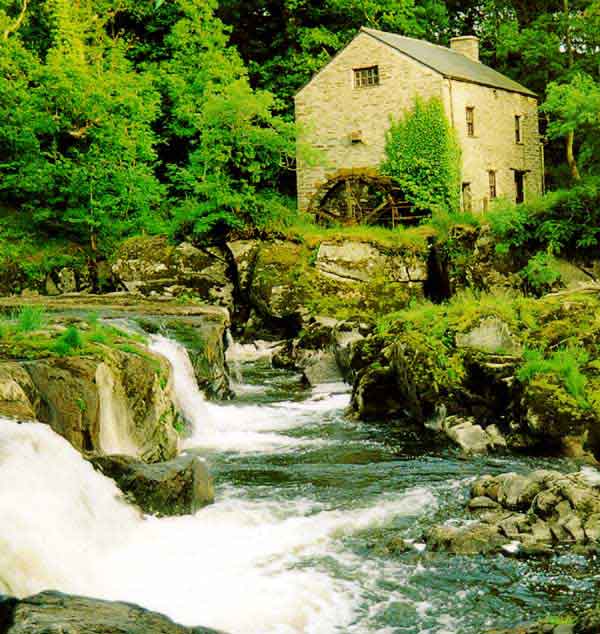
Picture taken by Gilbert Parkinson, reproduced courtesy of Cenarth Holiday Park
It has not been my intention to promote the holiday trade specifically but this is worth a mention in the context of our main story. As well as the usual facilities for rural holidays, walking, fishing, pony trekking etc. and the fact that many beaches are within easy reach it is possible in this area to sail in a coracle. These little boats of waterprooofed hide stretched over a willow frame go back in time to long before recorded history began and were certainly used in this area in the Celtic period. They are still used for fishing and by people involved in maintaining the riverside environment. Should you decide to try your hand there is a definite skill involved in staying afloat but don't worry, the rivers are shallow and experienced coracle men are on hand. It can't be any harder than windsurfing can it?
Visit the official CENARTH HOLIDAY PARK website or mail the manager using the mailbox cenarth.falls@saqnet.co.uk if my link is not available.

We are nearing the end of our journey now as we steer north again towards Pontarfynach - Devil's Bridge. This famous scenic highlight is situated high in Plynlymmon mountains about ten miles to the east of Aberystwyth. If you missed our other narrow gauge railways the ride on this one is equally worthwhile.
However you arrive there is plenty worth seeing:
The Bridge itself, or rather the three bridges built on top of each other has this legend attached to it.
| One day old Megan of Llandunach stood by the side of the river Mynach wondering what she should do.
The river was in flood, and raced down the wooded cwm in five successive falls, tumbling over three hundred feet in less than no time. Near to where Megan was standing, was a great natural cauldron dangerous enough even in the dry summer but now filled with angry white water that roiled bubbled into a vortex as if stirred by some supernatural being. From the cauldron the river plunged down a narrow, deep ravine. At other times Megan could enjoy the beauty of the place, she loved all things of nature but on this day the sight of the seething punchbowl and the cataract beyond filled her with trepidation.
Megan was a poor woman and her only milk cow was on the far side of the ravine. How ever could she persuade the beast which to cross such a terrible torrent. The cow was enjoying the lush green grass and did not care what side of the river it was on. How the animal had got in the first place Megan could not tell, and still less did she know how to get it back.
As there was no one else to talk to, she talked to herself. "Oh dear, what shall I do?" she said.
"What is the matter, Megan?" said a voice behind her.
She turned round and saw a man cowled like a monk and with a rosary at his belt. She had not heard anyone coming, because of the noise made the waters crashing over and through the rocks. Also she was preoccupied with the problem of the cow that she could not stop to wonder how the stranger had come up.
"I am ruined," said Megan. "There is my one and only cow, the sole support of my old age, (don't these old women in folk tales have a wonderful sameiness to them) she is on the other side of the river, and I don't know how to get her back again. Oh dear, oh dear, I am ruined."
"Don't you worry about that," said the monk. "I'll get her back for you."
"How can you?" asked Megan, greatly surprised.
"I'll tell you," answered the stranger. "It is one of my amusements to build bridges, and if you like, I'll throw a bridge across this chasm for you."
"Well, indeed," said the old woman, "nothing would please me better. But how am I to pay you? I am sure you will want a great deal for a job like this, and I am so poor that I have no money to spare, look you, no indeed."
"I am very easily satisfied," said the monk. "Just let me have the first living thing that crosses the bridge after I have finished it, and I shall be content."
Megan agreed to this, and the monk told her to go back to her cottage and wait there until he should call for her.
Now, Megan was not half such a fool as she looked, and she had noticed, while talking to the kind and obliging stranger, that there was something rather peculiar about his foot. She had a suspicion, too, that his knees were behind instead of being in front, and while she was waiting for the summons, she thought so hard that it made her head ache.
By the time she was halloed for, she had hit upon a plan. She threw some crusts to her little dog to make him follow her, and took a loaf of bread under her shawl to the riverside.
"There's a bridge for you," said the monk, pointing proudly to a fine span bestriding the yawning chasm. And it really was something to be proud of.
"H'm, yes," said Megan, looking doubtfully at it. "Yes, it is a bridge. But is it strong?"
"Strong?" said the builder, indignantly. "Of course it is strong."
"Will it hold the weight of this loaf?" asked Megan, bringing the bread out for underneath her shawl.
The monk laughed scornfully. "Hold the weight of this loaf? Throw it on and see. Ha, ha!"
So Megan rolled the loaf right across the bridge, and the little black mutt chased after it.
"Yes, it will do," said Megan. "And, kind sir, my little dog is the first live thing to cross the bridge. You are welcome to him, and I thank you very much for all the trouble you have taken."
"Tut, the silly dog is no good to me," said the stranger, very crossly, and with that he vanished into space.
From the smell of brimstone which he had left behind him, Megan knew that, as she had suspected, it was the devil whom she had outwitted.
And this is how the first Devil's Bridge came to be built. |
|
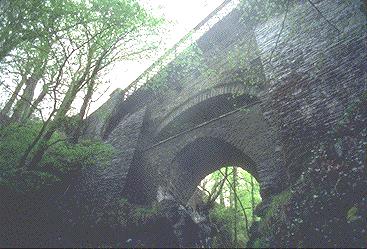
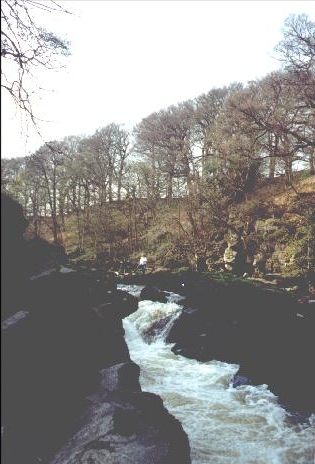

| Pictures: Top; the Three Bridges Middle; the Cataract Bottom; A cascade below the bridge.
(This is not a view you will see again. Only a complete idiot would scramble over wet rocks to this viewpoint...)
All Pictures by Ian Thorpe. |
|
I took the tale from a very old book bought at a second hand stall in Cardigan Market. Unfortunately the book was not, as the stallholder said, an antique but it was worth the five pounds for that story.
The original bridge was believed to have been built either by the Cistercian monks of Strata Florida abbey or by Knights Templar.
Two paths lead down on either side of the bridges. Sensible footwear and appropriate (waterproof) dress is recommended. The longest, and steepest, path leads down to the valley floor affording wonderful views of the cascading falls; crosses the raging torrent and climbs all the way up again. The climb back up to Devil's Bridge is something that not all those who venture down realise lies before them. This path is definitely not for people with mobility, breathing or circulatory problems.
The second path, to the east of the three bridges does not involve such a climb. It affords magnificent views of the cataract carved through the solid rock and also has the viewpoint from where our picture of the Bridges was taken.
The scenery in the area around Devil's Bridge provides many opportunities for walkers and photographers.
 From Devil's Bridge we are heading straight for Shrewsbury, the modern town closest to Viroconium. On our journey so far we have travelled the length of Mogwydd's Land and the Celtic population tended to live in the fertile valleys close to the coast. So this inland area of rugged mountains contains spectacularly beautiful scenery but not a lot of ancient history.
From Devil's Bridge we are heading straight for Shrewsbury, the modern town closest to Viroconium. On our journey so far we have travelled the length of Mogwydd's Land and the Celtic population tended to live in the fertile valleys close to the coast. So this inland area of rugged mountains contains spectacularly beautiful scenery but not a lot of ancient history.
Although I was born in Manchester, a large industrial city my family left when I was very young and Shrewsbury is the place where I grew up. This excursion into England for the last part of our tour is not entirly inappropriate as national borders tended to be very flexible until several hundred years after the Norman Conquest and tows like Shrewsbury and Chester where will will go next are as much Welsh as English. Just listen to the surnames of my childhhod friends, Edwards, Williams, Jones, Pritchard, Bayliss, Morris. Not a Smith or a Brown among them. Lets visit the town and surrounding area (pictures courtesy of virtual- shropshire)
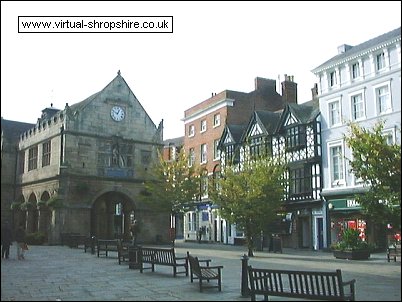
I cannot remember how old the present Guild Hall is but this area has been a Market Square and meeting place since Saxon times and probably before. Most of the buildings on this street date from the eighteenth century or earlier. The large timbered house is not mock Tudor, it is the real thing.
 My favourite place was the Castle and I would get into the grounds whenever I could. Shrewsbury Castle has a well preserved dungeon block including an oubliette, the very deepest dungeon in the prison. The word comes from the French verb "oublier" - "to forget" and that is what they did. If you were convicted of crimes not bad enough to warrant the death penalty - and most crimes carried the death penalty in those days - but lets say something like upsetting the Sheriff by making eyes at his daughter, they would throw you (literally, there were no steps) in the oubliette and forget all about you. No food, no exercise, no parole.
My favourite place was the Castle and I would get into the grounds whenever I could. Shrewsbury Castle has a well preserved dungeon block including an oubliette, the very deepest dungeon in the prison. The word comes from the French verb "oublier" - "to forget" and that is what they did. If you were convicted of crimes not bad enough to warrant the death penalty - and most crimes carried the death penalty in those days - but lets say something like upsetting the Sheriff by making eyes at his daughter, they would throw you (literally, there were no steps) in the oubliette and forget all about you. No food, no exercise, no parole.
It was not a nice fate but there were always a few skeletons for company.
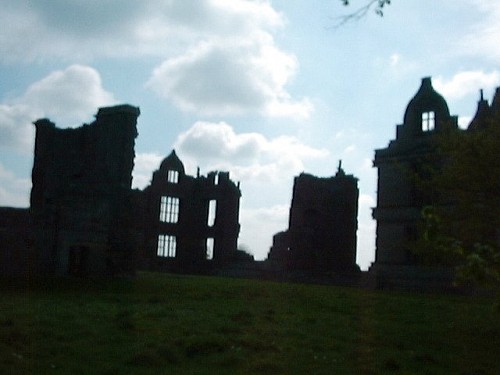 As well as the historic buildings in the town itself there are many stately homes in the surrounding area Some, like Moreton Hall shown here are ruins, many others offer access to the public. Shropshire is one of the few pastoral counties left in England and is an ideal destination for antique hunters. As well as the numerous shops in all the towns and many villages, bargains can be found in auctions on any day of the week, but remember the golden rule of auctions, caveat emptor - buyer beware. You might think something is cheap as chips (Manchester expression) but in reality your priceless antique could turn out to be reproduction "tat" from a sweatshop in Kowloon.
As well as the historic buildings in the town itself there are many stately homes in the surrounding area Some, like Moreton Hall shown here are ruins, many others offer access to the public. Shropshire is one of the few pastoral counties left in England and is an ideal destination for antique hunters. As well as the numerous shops in all the towns and many villages, bargains can be found in auctions on any day of the week, but remember the golden rule of auctions, caveat emptor - buyer beware. You might think something is cheap as chips (Manchester expression) but in reality your priceless antique could turn out to be reproduction "tat" from a sweatshop in Kowloon.

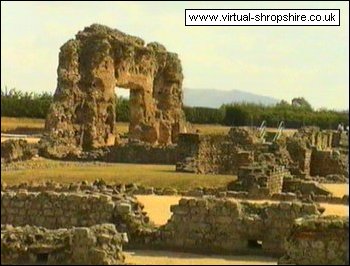 For people interested in the Roman Empire, or anybody who has sufficiently enjoyed An Ashless Fire to want to know more about the setting a visit to the village of Wroxeter on the A5 road out of town is a must. This is where you will find the ruins of the Roman settlement of Viroconium
For people interested in the Roman Empire, or anybody who has sufficiently enjoyed An Ashless Fire to want to know more about the setting a visit to the village of Wroxeter on the A5 road out of town is a must. This is where you will find the ruins of the Roman settlement of Viroconium
The ruins here are not so well preserved as those at Chester but the site museum is most informative.
 On the North East side of town is the ruin of Haughmond Abbey. Like most of the other monasteries in England Haughmond was sacked by King Henry VIII when he established the Church of England in defiance of the Pope. The buildings of the Abbey community stood at the foot of Haughmond Hill and the monks used to graze their animals on its common land as well as farming the fertile meadows surrounding the church. Haughmond Hill holds special memories. It was still common land when I was a child and in those less dangerous times provided an adventure playground for children from the villages in the area, the kind of place that might fire a child's imagination with ideas that would last a lifetime.
On the North East side of town is the ruin of Haughmond Abbey. Like most of the other monasteries in England Haughmond was sacked by King Henry VIII when he established the Church of England in defiance of the Pope. The buildings of the Abbey community stood at the foot of Haughmond Hill and the monks used to graze their animals on its common land as well as farming the fertile meadows surrounding the church. Haughmond Hill holds special memories. It was still common land when I was a child and in those less dangerous times provided an adventure playground for children from the villages in the area, the kind of place that might fire a child's imagination with ideas that would last a lifetime.
 Last stop is Chester, built on the old Roman city of Deva and one of the most popular tourist destinations in the UK. We stared from Caernarfon on a stretch of coast where the Vikings first landed in Wales in the eighth century and have made a loop around the area that was a Druid stronghold until after the Norman Conquest of 1066 and a place where the traditions of the Celtic Christians have lived on. Also we are at the point in route that is closest to the area's two international airports, Manchester and Liverpool.
Last stop is Chester, built on the old Roman city of Deva and one of the most popular tourist destinations in the UK. We stared from Caernarfon on a stretch of coast where the Vikings first landed in Wales in the eighth century and have made a loop around the area that was a Druid stronghold until after the Norman Conquest of 1066 and a place where the traditions of the Celtic Christians have lived on. Also we are at the point in route that is closest to the area's two international airports, Manchester and Liverpool.
Let's go shopping first.

"The Rows" are unique to Chester. These very old buildings provided two rows of shops, one at street level and one accessed from a promenade above. The more mundane trades, butchers, provisions merchants, vintners etc. would occupy street level while the jewellers, silk merchants, spice shops and other more exotic lines worked in luxury at the higher level.
From theRoman period until the early eighteenth century Chester was one of the most important towns in England, the sailing ships could navigate the esturary of the River Dee and its position enabled the garrison to dominate the North West route to Scotland and the sea crossing to Ireland. The Industrial revolution and the development of the American economy changed things. Bigger ships were unable to use the River and trade went via Liverpool to the cotton mills and coalfields of Manchester and East Lancashire. Politically Chester was still important and its assay office is one of the oldest in the nation. Jewellery bearing the Chester hallmark is highly prized by collectors.
Dominating the main street on a gantry that spans the main street is this ornate clock, a gift to the citizens by a local businessman in appreciation for his being awarded the freedom of the city. Like any ancient city Chester has its fair share of ghost stories and visitors with nerves of steel can for a small price join one of several ghost walks.
A visit to Chester would not be complete without taking a look at the Roman ruins.
The baths (above left) was the social centre of any substantial Roman settlement. Much can be seen of the bathouse, in this picture a raised floor which allowed heat from the furnaces to flow under the paving stones making them more comfortable for bare feet to walk on. The amphitheatre (above right) is among the most recent excavations. It would have been another social centre, a place where people would gather to watch plays or hear recitals of music or poetry. If you are wanting to see where the Gladiators strutted their stuff that would be a Circus, a large round theatre similar to the Colosseum in Rome but on a smaller scale, but I do not know if one has been discovered at Chester.
From the area where most remnants of the Ancient city are to be found it is possible to walk along the old Roman Wall to St.Werburghs Cathedral, a magnificent medieval styled building that is open to the public for viewing 6 days a week and for worship on all 7.
Like most Cathedrals it has been added to over the centuries but a Church has stood on this site since 907AD when the Abbey community here built one to house the remains of St. Werburgh. From 1092 to 1540 St Werburgh's Church was part of a Benedictine Abbey. The present structure contains materials from that original Saxon building.
That is the end of our tour of Mogwydd's Land. There are many places we have not been able to visit and far too many stories to tell. As I plan to progress from CD to DVD for future projects I am thinking of revisiting the project to make a video tour. But for now your transport is waiting to take you to the airport. We hope you enjoyed the visit and will return.
RELATED POSTS:
Alchemy For Beginners - Part 1: A Condensed history Of Alchemy
Religion and Science have in recent times not been comfortable bedfellows. Strange then that the earliest scientists were priests, people who chose todevote their lives to the pursuit of knowledge and understanding. One early science much derided by modern scientists was Alchemy, the quest to turn base metals like lead into Gold. But was the althemists idea really daft?
A Sense of Self - Are We Forgetting How To Be
In the 1920s D H Lawrence said; "Mankind has to get back in touch with the rhythms of nature." Instead we moved away from nature and towards technocracy and now we face pandemics of depression and stress. Materially we in the west are better off than any generation before us. But somehow our ancestors and people in poor nations seem happier. Have we forgotten how to be and thus lost sight of who we are?
Meditations
Greenteeth suggests ways to escape from the insanity of the world.
 Greenteeth Labyrinth
Greenteeth Labyrinth Cwm Tudu means Bay of Seals. If you look very closely on the picture towards the right and about a third up from the bottom the small black dot is a seals head. They seemed reluctant to pose for the camera, but on that day a group of young men on the beach were having great fun throwing stones when the creatures came close to the beach. Our politicians, when justifying tax increases like to tell us what a wonderful education system they provide.
Cwm Tudu means Bay of Seals. If you look very closely on the picture towards the right and about a third up from the bottom the small black dot is a seals head. They seemed reluctant to pose for the camera, but on that day a group of young men on the beach were having great fun throwing stones when the creatures came close to the beach. Our politicians, when justifying tax increases like to tell us what a wonderful education system they provide. 


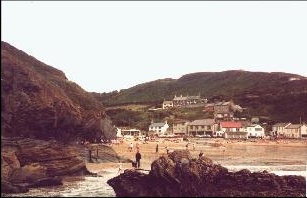

 Because of the urbanisation surrounding the Castle there is not really a good viewpoint but on the day we visited we did manage some good interiors, showing the subterranean passages that were a feature of so many medieval castles. These often provided an escape route for the Lord and his family if things were getting too hot.
Because of the urbanisation surrounding the Castle there is not really a good viewpoint but on the day we visited we did manage some good interiors, showing the subterranean passages that were a feature of so many medieval castles. These often provided an escape route for the Lord and his family if things were getting too hot.
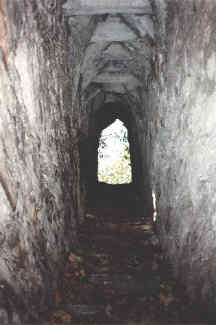





 My favourite place was the Castle and I would get into the grounds whenever I could. Shrewsbury Castle has a well preserved dungeon block including an oubliette, the very deepest dungeon in the prison. The word comes from the French verb "oublier" - "to forget" and that is what they did. If you were convicted of crimes not bad enough to warrant the death penalty - and most crimes carried the death penalty in those days - but lets say something like upsetting the Sheriff by making eyes at his daughter, they would throw you (literally, there were no steps) in the oubliette and forget all about you. No food, no exercise, no parole.
My favourite place was the Castle and I would get into the grounds whenever I could. Shrewsbury Castle has a well preserved dungeon block including an oubliette, the very deepest dungeon in the prison. The word comes from the French verb "oublier" - "to forget" and that is what they did. If you were convicted of crimes not bad enough to warrant the death penalty - and most crimes carried the death penalty in those days - but lets say something like upsetting the Sheriff by making eyes at his daughter, they would throw you (literally, there were no steps) in the oubliette and forget all about you. No food, no exercise, no parole. As well as the historic buildings in the town itself there are many stately homes in the surrounding area Some, like Moreton Hall shown here are ruins, many others offer access to the public. Shropshire is one of the few pastoral counties left in England and is an ideal destination for antique hunters. As well as the numerous shops in all the towns and many villages, bargains can be found in auctions on any day of the week, but remember the golden rule of auctions, caveat emptor - buyer beware. You might think something is cheap as chips (Manchester expression) but in reality your priceless antique could turn out to be reproduction "tat" from a sweatshop in Kowloon.
As well as the historic buildings in the town itself there are many stately homes in the surrounding area Some, like Moreton Hall shown here are ruins, many others offer access to the public. Shropshire is one of the few pastoral counties left in England and is an ideal destination for antique hunters. As well as the numerous shops in all the towns and many villages, bargains can be found in auctions on any day of the week, but remember the golden rule of auctions, caveat emptor - buyer beware. You might think something is cheap as chips (Manchester expression) but in reality your priceless antique could turn out to be reproduction "tat" from a sweatshop in Kowloon. For people interested in the Roman Empire, or anybody who has sufficiently enjoyed An Ashless Fire to want to know more about the setting a visit to the village of Wroxeter on the A5 road out of town is a must. This is where you will find the ruins of the Roman settlement of Viroconium
For people interested in the Roman Empire, or anybody who has sufficiently enjoyed An Ashless Fire to want to know more about the setting a visit to the village of Wroxeter on the A5 road out of town is a must. This is where you will find the ruins of the Roman settlement of Viroconium On the North East side of town is the ruin of Haughmond Abbey. Like most of the other monasteries in England Haughmond was sacked by King Henry VIII when he established the Church of England in defiance of the Pope. The buildings of the Abbey community stood at the foot of Haughmond Hill and the monks used to graze their animals on its common land as well as farming the fertile meadows surrounding the church. Haughmond Hill holds special memories. It was still common land when I was a child and in those less dangerous times provided an adventure playground for children from the villages in the area, the kind of place that might fire a child's imagination with ideas that would last a lifetime.
On the North East side of town is the ruin of Haughmond Abbey. Like most of the other monasteries in England Haughmond was sacked by King Henry VIII when he established the Church of England in defiance of the Pope. The buildings of the Abbey community stood at the foot of Haughmond Hill and the monks used to graze their animals on its common land as well as farming the fertile meadows surrounding the church. Haughmond Hill holds special memories. It was still common land when I was a child and in those less dangerous times provided an adventure playground for children from the villages in the area, the kind of place that might fire a child's imagination with ideas that would last a lifetime.
